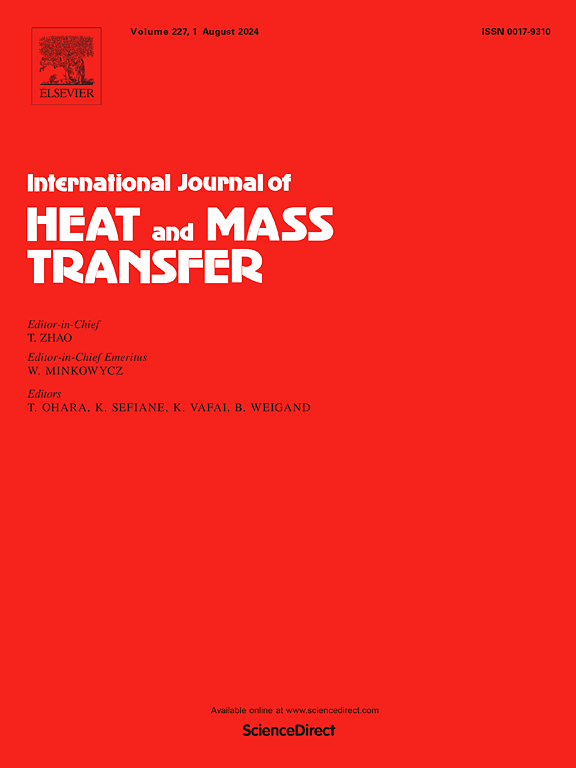Analysis of the thermal behavior of a large format lithium-ion battery cell in a constant-power discharge process
IF 5
2区 工程技术
Q1 ENGINEERING, MECHANICAL
International Journal of Heat and Mass Transfer
Pub Date : 2025-06-26
DOI:10.1016/j.ijheatmasstransfer.2025.127435
引用次数: 0
Abstract
Most electrochemical-thermal models for lithium-ion battery (LIB) cells simulate constant-current discharge, which makes it difficult to accurately replicate the operation of devices that actually use LIB cells. To address this issue, the 3D electrochemical-thermal model used in this study is developed to analyze the electrochemical and thermal behavior of a commercial large-format NMC622 battery cell under constant-power discharge conditions. In more detail, a multiphysics numerical model capable of coupled analysis of charge transport, mass transport, and energy balance phenomena occurring during battery operation has been developed. Through this, a foundation is established for easily identifying electrochemical-thermal behaviors that are difficult to analyze experimentally. Based on the completed numerical model, constant-power analysis, rather than constant-current analysis, is conducted to simulate the power control process of an actual electric vehicle. Various heat generation mechanisms—including reaction heat, activation heat, electronic ohmic heat, and ionic ohmic heat—are thoroughly analyzed. The developed three-dimensional model is experimentally validated with respect to voltage, current, and temperature. Based on the validated model, the thermal behavior during discharge is analyzed. It is found that in the commercial cell considered in this study, ionic ohmic heat dominates during high-power discharge, while reversible reaction heat dominates during low-power discharge. Detailed heat analysis shows that most heat is generated in the two electrodes, with the negative electrode contributing the most. Due to reaction heat, an endothermic reaction occurs in the negative electrode at the early stage of discharge. Furthermore, the analysis of activation heat confirms that a significant activation overpotential develops in the positive electrode near the end of discharge. The localized heat generation is greater in the side surface (thickness direction) rather than on the front surface of the cell, as confirmed by simulation. Finally, the effect of cell geometry is investigated. The results show that as the electrode becomes thinner, lithium-ion transport becomes more efficient, leading to improved electrochemical and thermal performance.
大尺寸锂离子电池恒功率放电过程的热行为分析
大多数锂离子电池(LIB)的电化学-热模型模拟的是恒流放电,这使得很难准确地复制实际使用锂离子电池的设备的操作。为了解决这一问题,本研究中使用的3D电化学-热模型用于分析商用大尺寸NMC622电池在恒功率放电条件下的电化学和热行为。更详细地说,建立了一个能够耦合分析电池运行过程中电荷输运、质量输运和能量平衡现象的多物理场数值模型。通过这种方法,为容易识别难以通过实验分析的电化学-热行为奠定了基础。在完成数值模型的基础上,进行恒功率分析,而不是恒流分析,来模拟实际电动汽车的功率控制过程。各种热的产生机制,包括反应热,活化热,电子欧姆热,离子欧姆热进行了深入的分析。所建立的三维模型在电压、电流和温度方面进行了实验验证。在验证模型的基础上,分析了放电过程中的热行为。研究发现,在本研究考虑的商用电池中,高功率放电时离子欧姆热占主导地位,而低功率放电时可逆反应热占主导地位。详细的热分析表明,大部分热量在两个电极中产生,其中负极贡献最大。由于反应热的存在,在放电初期负极发生吸热反应。此外,对活化热的分析证实,在接近放电结束的正极中产生了显著的活化过电位。模拟结果表明,侧表面(厚度方向)的局部产热比电池前表面的局部产热更大。最后,研究了单元几何形状的影响。结果表明,电极越薄,锂离子的传输效率越高,从而改善了电化学和热性能。
本文章由计算机程序翻译,如有差异,请以英文原文为准。
求助全文
约1分钟内获得全文
求助全文
来源期刊
CiteScore
10.30
自引率
13.50%
发文量
1319
审稿时长
41 days
期刊介绍:
International Journal of Heat and Mass Transfer is the vehicle for the exchange of basic ideas in heat and mass transfer between research workers and engineers throughout the world. It focuses on both analytical and experimental research, with an emphasis on contributions which increase the basic understanding of transfer processes and their application to engineering problems.
Topics include:
-New methods of measuring and/or correlating transport-property data
-Energy engineering
-Environmental applications of heat and/or mass transfer

 求助内容:
求助内容: 应助结果提醒方式:
应助结果提醒方式:


